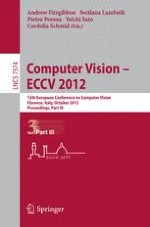2012 | Book
Computer Vision – ECCV 2012
12th European Conference on Computer Vision, Florence, Italy, October 7-13, 2012, Proceedings, Part III
Editors: Andrew Fitzgibbon, Svetlana Lazebnik, Pietro Perona, Yoichi Sato, Cordelia Schmid
Publisher: Springer Berlin Heidelberg
Book Series : Lecture Notes in Computer Science
